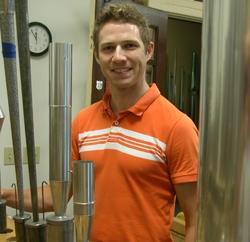
Jonathan Young has been appointed to the tonal department of John-Paul Buzard Pipe Organ Builders as Associate to Tonal Director Brian Davis. Young is director of music at the Catholic Church of the Immaculate Conception in Mattoon, Illinois, and completing the Doctor of Musical Arts in organ performance and literature at the University of Illinois, where he studies with Dana Robinson.
Originally from Moses Lake, Washington, he holds a bachelor’s degree in organ performance from Pacific Lutheran University in Tacoma, Washington, and a master’s degree in organ performance and literature from the Eastman School of Music. His organ teachers have included Hans Davidsson, Paul Tegels, Susan Ferré, James Holloway, and David Dahl, as well as harpsichordists Charlotte Mattax, William Porter, and Kathryn Habedank, and pianist Jairo Geronimo.
Young was the alternate winner of the 2011 Mu Phi Epsilon International Competition. In 2003 he was selected as the Westfield Center Concert Scholar, through which he presented recitals at Oberlin Conservatory and Stanford University; he was also the winner of the Christ Church Regional Young Organists’ Competition in Tacoma the same year. In 2004 he was awarded the James D. Holloway Music Scholarship at PLU, and the Brownson Fellowship at the University of Illinois in 2006.
Young was a Senior Lecturer and Visiting University Organist at PLU for the 2009–10 academic year, where he taught courses in music history, introduction to music, ear training, organ, and directed the Chapel Choir. Prior to his appointment at PLU, he held a teaching assistantship at the University of Illinois and was organist at First Presbyterian Church of Urbana. He has also been director of music at St. Peter’s Episcopal Church in Henrietta, New York, and organist at First United Methodist Church of Tacoma and the Main Post Chapel at Joint Base Lewis-McChord, Washington.
Young has appeared on several recordings with the PLU Choir of the West and Choral Union as an accompanist and soloist, most recently the Choral Union’s 2011 25th anniversary album featuring Britten’s The Company of Heaven and movements from Kodaly’s Missa Brevis. He has performed as a soloist with the Baroque Artists of Champaign-Urbana (BACH), and has sung with BACH and Prairie Voices, a Champaign-area a capella choir, as well as Tacoma-based Alumni Men’s Chorale.
Jonathan Young began working at Buzard Pipe Organ Builders part-time in the service department in 2011. Under direction of Tonal Director Brian Davis, his duties and responsibilities will include prepping and racking pipes, doing in-house voicing on flues and reeds for new organ and rebuild projects, providing musical input on projects and setting samples along with the tonal director after initial discussion of a project. General organbuilding skills will not be ignored, in particular, woodworking skills.

